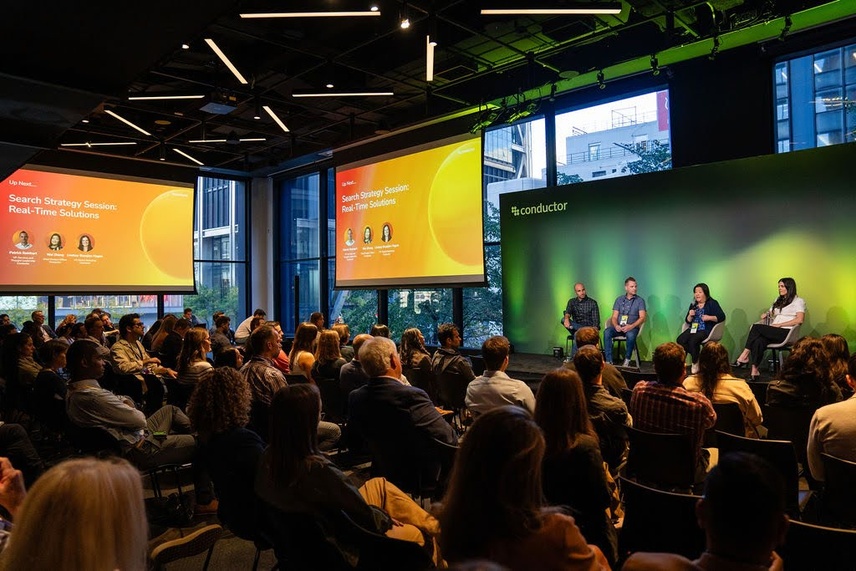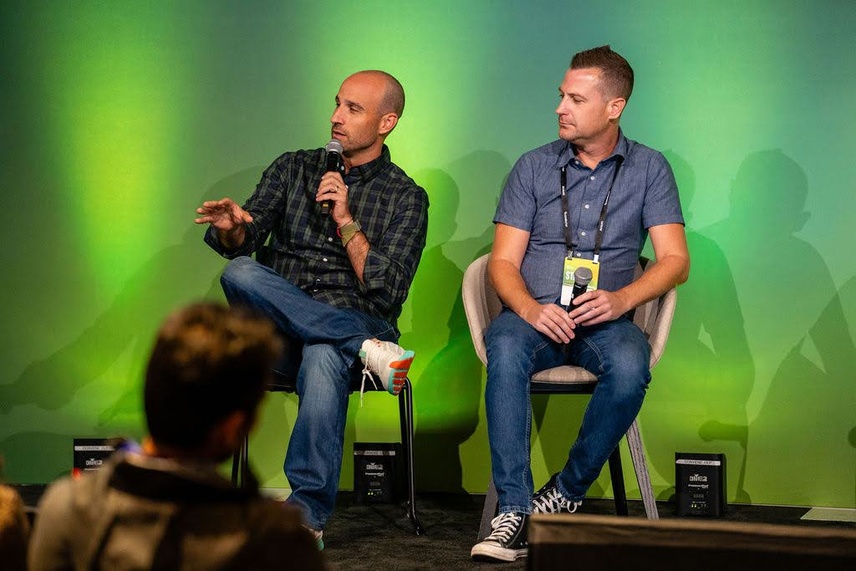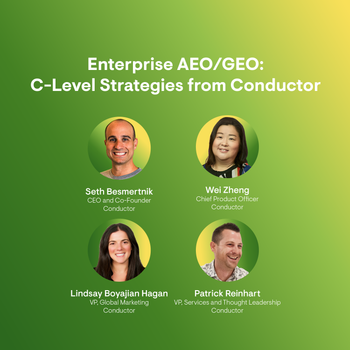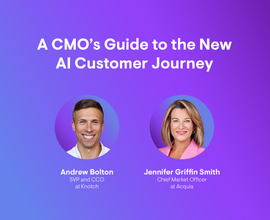Enterprise AEO / GEO: C-Level Strategies from Conductor
- Thought Leadership
- By Nicole Wanichko
- 14 minutes read
Real answers to real challenges: AI adoption for risk-averse teams, content optimization without velocity, and authentic Reddit engagement.
AI search has moved enterprise SEO into the boardroom—and that executive attention changes everything. The pressure to act is real, but so are the obstacles: limited budgets, risk-averse stakeholders, stretched teams, and platforms that punish inauthenticity. Success requires strategies built for these realities, not ideal conditions.
These insights are from a leadership Q&A at C3 2025, New York's premier AEO / GEO conference, brought to you by Conductor, featuring:
- Seth Besmertnik, CEO and Co-Founder at Conductor
- Wei Zheng, Chief Product Officer at Conductor
- Patrick Reinhart, VP Services and Thought Leadership at Conductor
- Lindsay Boyajian Hagan, VP, Global Marketing at Conductor
What followed was an honest, no-holds-barred discussion that ranged from tactical advice to bold predictions about the future of search—here's what matters most:
- Break through AI resistance with data, not empathy alone: Show risk-averse executives competitive analysis that demonstrates urgency, or bring in third-party experts who can deliver the hard truth about falling behind.
- LLM partnerships are possible now—Google's window has closed: Conductor's deep partnership with OpenAI proves the AI search landscape is still budding, creating opportunities for early engagement and influence that never existed with traditional search.
- Content depth beats velocity for AI visibility: When you can't scale production, focus on making existing content richer, more structured, and more authoritative through FAQs, data tables, and product specs that AI can consume.
- Reddit authenticity means product experts, not marketers: Send people who actually build your products to engage openly as company representatives, focused on helping rather than selling in this volatile environment.
- Radical transparency can be a competitive advantage: Opening up competitive comparisons and product information benefits customers, AI systems, and internal operations—what seems risky often delivers unexpected value.
- Product metadata is your new content strategy: Data and content are becoming the same thing in AI search—structure your product information now, or let competitors control your discovery presence in ChatGPT shopping.

How do you convince a risk-averse company to embrace AI?
For enterprise SEO professionals not in the C-suite, breaking through organizational resistance to AI visibility can feel impossible—especially when leadership refuses to acknowledge that consumers are even using AI search.
Patrick Reinhart: Start with data first, rather than just saying what you want them to hear. The best way to do this is to scare them. Show executives exactly how competitors are winning and how poorly you're performing by comparison. Demonstrate what competitors are doing in AEO / GEO and how much visibility they're capturing while you're falling behind. You can't ignore this reality—that competitive gap is what starts the conversation about what you need to do.
Wei Zheng: You should come from an angle of empathy—understand why they're reluctant. People aren’t reluctant just because they want to be. They have real concerns—what if AI hallucinates? What if AI doesn't give all the right information?
Just because you're afraid [of AI] doesn't mean it doesn't exist.
Show them that you understand their worries about hallucination and accuracy concerns—this is why you can't shy away from it. Consumers are going to AI. They're asking about drugs, medical treatment, and insurance policies. They're asking all these regulated questions. If you're not trying to provide or find a solution for it, the problem gets worse for you as a brand.
Empathy is important, but this is also a problem that needs solving.

Seth Besmertnik: Use all your collateral and bring in third-party experts to meet with your executives. Have someone outside your organization tell them:
[Brands] are on a surefire path to failing unless they embrace AI and change.
I had a meeting last week with someone in a regulated industry who said they couldn't use AI. We left that meeting with their leadership reconsidering—they realized they might need to challenge some assumptions and start using it.
Are LLM companies willing to partner? How helpful are they compared to Google?
Understanding whether LLM companies will partner with enterprise platforms is critical for AEO / GEO strategy. Conductor's experience working directly with OpenAI provides insight into what's possible—and how different this landscape is from Google.
Wei Zheng: We've been talking extensively with OpenAI. We're in the top 30 of their token consumers, and there's a reason you don't see anyone else from our industry up there. We chose this path deliberately because we're in the early stages. When this game was being played with Google, it was too late—they already had ads, and everyone had Search Console and Keyword Planner. We're at the nascent stage right now with AI search.
Conductor is an enterprise partner of OpenAI. We've been transparent and evangelists for the entire MarTech industry. We have dedicated account managers, and I've been speaking directly with the ChatGPT product management team.
One of the reasons to partner with Conductor is that we really do want to do [AI] the right way. We're a large company, so I have all the customers behind me. When I go talk to OpenAI, the enterprise account manager says, 'Would you come and talk to our product team? But by the way, bring your customers, too.
Everyone wants to know if there's going to be an OpenAI Search Console. The latest information I have is that as they roll out shopping results with partners like Etsy and Shopify, they'll need to produce analytics data for merchants and brands selling through ChatGPT. That's essentially like Google Analytics—it won't give competitive data yet, but it's better than being completely blind.
We've had more meetings with OpenAI in the last three weeks than Google in the last 20 years.
What wildly outrageous or innovative tactics have you seen brands trying in AI search?
The push for AI visibility is driving tactics from ethically questionable to strategically bold. Conductor's leadership breaks down what they're encountering—the good, the bad, and the surprisingly effective.
Patrick Reinhart: A lot of people are creating what's called “AI slop”—using APIs to generate content in certain niches and creating multiple domains to push down larger brands and capture AI visibility. Then they monetize through ad space or affiliate links, gambling on how long they can keep these sites live before they get taken down.
When they do get shut down, they just build more. They're running this agentically now, which makes it even more problematic. It's a complete waste of time in my view, but it's working for them in some capacity.
Seth Besmertnik: In our business, everybody wants competitive comparisons. For years, our sales team used comparison sheets and documents, but we decided to take a completely different approach—we put everything on our website, where anyone can access it.
Visit Conductor.com, click on the first or second tab, and you'll see a drop-down. The first thing you see? All our competitor names and detailed comparisons showing how we stack up against them. It's open for competitors, AI systems, and potential customers to review.
We also built a comprehensive knowledge base with every detail about how our product works—all the features, idiosyncrasies, and configurations. We opened it entirely. You can ask ChatGPT questions about how to configure and use Conductor's platform.
Complete information transparency works. Open up your systems as much as possible. We had debates about the knowledge base—every competitor could see our roadmap, everything we can do, how we talk about them. But the net benefit? It's easier for customers, easier for AI systems, and easier for us to run the business.
We also FedExed all the CMOs of the Fortune 500. Someone got it and saved the letter—that was pretty cool.

Wei Zheng: One thing that bugs me—there's very little reliable data about AI search behavior right now. It's mostly anecdotes. I see LinkedIn thought-leadership posts claiming, "So-and-so published a study," but when you read the details, it's 2,000 data points being presented as the definitive pattern of consumer behavior.
There are two issues here. First, there's genuine demand for data and insights. Second, we need higher standards for how we present that data. My team knows that when we publish research or insights from our platform, I want complete transparency about sample size. How many data points are we analyzing? If it's a sample, what does it represent? What's the actual data set behind these conclusions?
Consume the information that's available, but always ask critical questions: How did they collect this data? What does it actually represent? Is it trustworthy enough to base your strategy decisions on?
If we can't increase content velocity, are we dead in the water?
Content velocity, the ability to publish and produce large volumes of content, has been positioned as critical for AI search success. For enterprise teams that can't scale production, this creates real anxiety about whether they can compete in AEO / GEO without massive content output.
Seth Besmertnik: You don't necessarily need 180 pieces of content. When you have a piece of content, it might not generate the engagement you want from someone visiting directly, but in the context of feeding AI systems, structure and depth matter more than volume.
If you have a really long, well-structured FAQ, data tables of product specs, buying characteristics—all of that can live on the page. You can even design your page so it looks appropriate for human scrollers, but for AI systems, if you structure that information well, it's not about content volume. It's about information breadth, depth, and authority.
Patrick Reinhart: Everyone should focus on the structure of your content. What is your particular point of view? What is the expertise of your organization? Dive deep into that expertise.
Instead of saying, "I'm not going to be able to put out 100 pieces of content this year," shift to "I can do 25 or 30." In those 25 or 30 pieces, structure things strategically. Focus on what makes your organization uniquely authoritative.
You're also going to start building a pipeline with other people in your organization. They may not create content immediately, but you can build a hopper and keep following up. Eventually, it'll get done. You can build a content pipeline for yourself over time.
Small teams have to think that way—filling the hopper and pushing it through. It might take longer, but focus on the structure and the technical aspects. Schema markup, structured data—those things matter. But it really comes down to focusing on the expertise you can extract and put out there. Then you build momentum by engaging people around your organization.
Seth Besmertnik: We had a customer in this exact situation—couldn't make content, couldn't scale production. Their traffic was declining. This was back in 2019.
We met with them and told them directly that they were going to go out of business if they couldn't get a better eCommerce platform. We delivered that message thoughtfully, but they ended up investing in a new eCommerce platform, spending two and a half years on the implementation, and their business has been performing well since then.
Help your company fix the fundamental problem, which is: You can't have a broken system forever.
How should companies engage with Reddit, especially around negative sentiment?
Reddit's importance in AI visibility has become impossible to ignore, but the platform's culture punishes inauthenticity. For brands concerned about negative sentiment and community backlash, the question isn't whether to engage—it's how to do it without making things worse.
Patrick Reinhart: What I've seen work best is having experts from your organization join the conversation authentically. More and more brands are taking this approach. Don't try to sell anything, don't offer coupons, don't get into fights with people—it's a volatile environment with a lot of arguments.
But ultimately, the best thing you can do is be transparent: I am from this company. Even put it in your handle. My friend from Sonos is here, and they run one of the best Reddit campaigns, period—they go in and troubleshoot, help people solve problems.
It's about sharing your knowledge and expertise and helping, and not trying to hide the fact that you're from the company.
Be upfront: "Hey, this is [name] from [company]. We're here to help." You're not trying to sell anything. Joining the conversations authentically is what I've seen work best in that volatile environment.
Wei Zheng: Some of the best Reddit engagement I've seen comes from people with genuine expertise—like what Patrick said—but specifically on the product side. Bring your product folks. Bring your builders who are going to be authentic and connect with people. A lot of people are looking for help. Even if they're bringing up a problem, acknowledging that there's an issue goes a long way.
Join the dialogue in an authentic way. That's the right way to engage on Reddit
How will product discovery change for consumers in the future with AI?
AI is fundamentally reshaping how consumers discover and purchase products, moving beyond traditional search behavior into conversational shopping experiences that require different data strategies.
Wei Zheng: Previously, when people made purchasing decisions, they shopped on Google. Content was created for human eyeballs—brand elements, images, and visual engagement.
But now, if you want recommendations in ChatGPT shopping, the game has changed. We've got customers who are ahead of this—they know they need visibility inside ChatGPT. They're working on their product feeds, which have fields that were traditionally just boring specs. Now they're figuring out how to add differentiated content so they can actually get discovered.
It's a wake-up call to content strategy. They've never thought about product data as content before. It's data.
Data and content are kind of starting to become synonymous. But you need to have a strategy because you're not going to have a human sitting there writing—you need a system to build this.
Patrick Reinhart: We're all going to be directly connected to these models through MCP server environments. It's going to be data flowing back and forth, especially for eCommerce and product feeds. The technical infrastructure for product discovery is fundamentally changing.
Seth Besmertnik: AI is just a better way to shop. I bought a TV recently for a family member. I said, "I need a TV this big, under $500, Netflix native, available now in one of these three stores." I listed it all out, and it gave me the options—boom, I checked out.
Brands need attribution metadata to support products and the buying experience. Take Wei's example from a Louis Vuitton presentation: "What was that bag David Beckham was wearing at that event?" Well, how does AI know that? It only knows if you've marked up your bags with metadata indicating which celebrities wore them, or if someone wrote content about it.
No one wants to leave their future in someone else's hands—you want control.
You have to structure [your product] data and make it available for the AI systems

In summary
AI isn't disrupting search—it's redefining how consumers discover, evaluate, and buy. The brands that win won't be the ones with the most content or the biggest budgets. They'll be the ones that moved early, built the right partnerships, and structured their data before competitors controlled the narrative.
The window for influence is open now in ways it never was with Google. Executive resistance breaks when you show competitive gaps. Small teams compete when they prioritize depth over volume. Authenticity wins when product experts engage openly. Transparency delivers value when you stop protecting information that should be accessible.
The future belongs to brands that treat content as data, build systems to scale it, and take control of their AI presence before someone else does it for them.
Conductor’s leadership shared these insights and more during their C3 2025 audience Q&A, Search-Strategy Session: Real-Time Solutions—watch the full recording below.
This conversation is derived from a C3 session—New York's premiere AEO / GEO conference—brought to you by Conductor, and has been edited for length and clarity.

![Wei Zheng, Chief Product Officer, [object Object]](https://cdn.sanity.io/images/tkl0o0xu/production/dcfa62c0fe34ba0c31f910b818874cd160ad8839-3542x3542.png?fit=min&w=100&h=100&dpr=1&q=95)
![Seth Besmertnik, CEO and Co-Founder, [object Object]](https://cdn.sanity.io/images/tkl0o0xu/production/79e6eda2a43959d9ac71253ccff188677b8260d8-3542x3542.png?fit=min&w=100&h=100&dpr=1&q=95)
![Patrick Reinhart, VP, Services and Thought Leadership, [object Object]](https://cdn.sanity.io/images/tkl0o0xu/production/9bc72298b24ad01b732de4c3376f79546d20f81c-3542x3542.png?fit=min&w=100&h=100&dpr=1&q=95)






